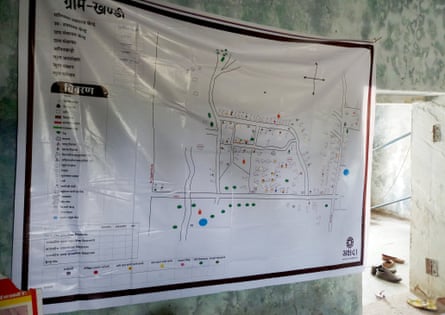It’s 10am and time for the first home visit of the day. After consulting a colour-coded map on the wall of the village centre, the three female health workers make their way through the winding lanes of a remote village in Jhalawar district, Rajasthan, where the rice has been harvested and garlic is being planted, to the home of Nirmala.
The yellow bindi (dot) on the map indicates that Nirmala and her children are highly likely to become malnourished without the proper care, which means the family is a priority for health services.
The three women tell Nirmala how important it is to breastfeed her newborn daughter, as she rocks her in a hammock made from a sari strung from the roof of her shack. Then they explain the importance of eating well and that her 18-month-old daughter must continue to receive extra food rations; she weighed only 1kg (2.2lbs) when she was born. Finally, they tell Nirmala the date of her next immunisation.
All this information has been loaded onto a tablet and is easily accessible to health workers via an app. It’s a smooth process, but it wasn’t always so.
Four years ago, Lata Nayar, an auxiliary nurse midwife, Vimla Gochar, a nutrition adviser, and Manju Suman, a volunteer trained in maternal and child health, worked separately. They didn’t share data about high-risk women and children and each reported to a different department and recorded their own information in the columns of bulky registers.
As a result, vulnerable women and children fell through the cracks. High-risk pregnancies were not monitored. Underweight children who were entitled to extra food rations failed to get them because they hadn’t been identified.
Today, however, all the data is compiled in one place and is easily accessed by the health workers on an app. All three women are aware in real time of any changes and updates, and all can take action to address or prevent problems, reducing maternal and child deaths.
Launched in Jhalawar, in Rajasthan state, by the Antara Foundation in 2015, the integrated programme, known as Akshada, focuses on the crucial 1,000 days between conception and the second year in a child’s life.
“They [the women] used to start in one area of the village and work sequentially, going from one house to another rather than first visiting the women and children who are most at risk. That meant delays. The key to reducing mortality is to identify the women and children and reach them fast,” says Ashok Alexander, founder of the Antara Foundation.

He suggested health workers draw a map of the villages in which they work and colour code the homes to indicate which families are most at risk.
“In one glance at the map, we know who to target,” says Gochar, sitting on the floor of the health centre. “Before, it could be weeks before we reached a high-risk pregnant woman. That cluster of yellow bindis are the homes of families who migrate for work. It’s hard for them to be regular in getting their children immunised or for pregnant women to get checked. We keep special track of them.”
Maps have now been used in 1,500 villages in Jhalawar district and the app in 150. The strategies have turned health workers into a unified force, and increased their effectiveness.
Based on monitoring data collected from a sample of more than 10% of villages in Jhalawar district, the identification of high-risk pregnancies increased by 60%, while the number of children under five identified as underweight increased by 117%.
As Nayar, Gochar and Suman walk around the village children shout: “Auntie, have you come to give us an injection?” A woman struggling under the weight of cattle fodder carried on her head stops them to ask when her child’s next immunisation is due.
At the home of Phoolbati, 24, who is pregnant with her third child, the health workers check that she is eating as well as her limited resources permit, and if she is receiving the special nutritional supplement given to pregnant women.

“Women generally listen. The only instruction they cannot follow is rest. Often they are rushed into the delivery room straight from working in the fields,” says Nayar.
She adds that when women find out their house is colour-coded yellow, “they are eager to get it removed as fast as possible by doing whatever we tell them”.
Encouraged by the initial findings, the foundation extended the project to the adjoining Baran district. It caught the attention of the Rajasthan government and is now being rolled out across 46,000 villages in the state, with more than 11 million beneficiaries.
The Antara Foundation is now also working in the states of Madhya Pradesh and Chhattisgarh, where the project is expected to reach more than 26 million women and children in the next four to five years, says Alexander.
“We are collecting the data from these states so that we can influence the national health policy,” Alexander says.
